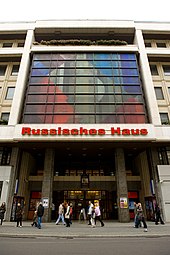Russian House of Science and Culture
The Russian House of Science and Culture (RHWK , short: Russian House, Russian Российский дом науки и культуры в Берлине РДНК) is an event and cultural center in Friedrichstrasse 176-179 in Berlin 's Mitte district . It opened on July 5, 1984 as the House of Soviet Science and Culture .
history
The building was rebuilt from 1981 to 1984 based on a design by the architect Karl-Ernst Swora on the site of an earlier commercial building that was destroyed in World War II . The realization was carried out by the newly formed construction management for special projects in the capital Berlin of a collective from the GDR Building Academy around Erhardt Gißke . High-quality materials such as granite from Lausitz for the facade and limestone from Wraza for the upper floors were used for the construction. The building has seven floors and an area of around 29,000 m². There is a colorful frieze above the entrance area .
The client was the Association of the Soviet Society for Friendship and Cultural Relations with Abroad. A classifying draft by Günter Stahn was rejected in advance. The implemented design by Swora did not correspond to the classicist style envisaged by the GDR leadership for Friedrichstrasse, but rather resembled the representative buildings of the Brezhnev era such as the ITAR-TASS headquarters, the White House in Moscow and the Soviet Academy of Sciences .
The facilities in the building served (as well as the Society for German-Soviet Friendship ) to strengthen bilateral ties and as a center for teaching the Russian language. It was the "largest of all Soviet foreign cultural centers" worldwide. The 1700 m² foyer was considered “one of the largest and most magnificent” in Berlin. There was a statue of Lenin in the foyer . The statue was removed from the building after German reunification in the early 1990s. The whereabouts of the statue is unknown.
After the end of the Soviet Union , the complex became the property of the Russian state . It has been renovated and parts have been re-leased. The Friedrichstrasse film theater and the Die Kneifzange cabaret were also established in the new building .
The merchant Franz Sedelmayer tried from 2008 to seize the building and the rents received because he was expropriated in Russia.
present
To a large extent, the institution continues to serve to strengthen bilateral cultural and scientific relationships. It is operated by the Federal Agency Rossotrudnitschestvo and directed by Pavel Iswolski.
The building contains rooms for exhibitions, conferences, concerts and a cinema. There are shops on the ground floor.
Web links
- Homepage of the Russian House of Science and Culture
- Homepage The book about the origin and history of the Russian House of Science and Culture
literature
- Wolfgang Kil : Founder's Paradise - On Building in Times of Transition; Pp. 87-89. Verlag für Bauwesen Berlin, Berlin 2000; ISBN 3-345-00747-9 .
- Valerij Sankov: The house on Friedrichstrasse. Berlin 2000.
Individual evidence
- ↑ A symbol of friendship in the heart of the capital. In: Neues Deutschland , July 6, 1984, p. 2
- ↑ Wolfgang Kil: Founder's Paradise - On Building in Times of Transition ; P. 87
- ↑ Friedrichstrasse 176–179 on berlin-friedrichstrasse.de
- ↑ Note with address to the film theater ( Memento from August 18, 2010 in the Internet Archive )
- ^ Website of the pincers
- ↑ Russian house will not be auctioned. In: Berliner Morgenpost. October 23, 2009, accessed March 21, 2020 .
- ^ Franz Sedelmayer against Russia In: Zeitmagazin 47/2014.
Coordinates: 52 ° 30 ′ 48.2 ″ N , 13 ° 23 ′ 20.1 ″ E

